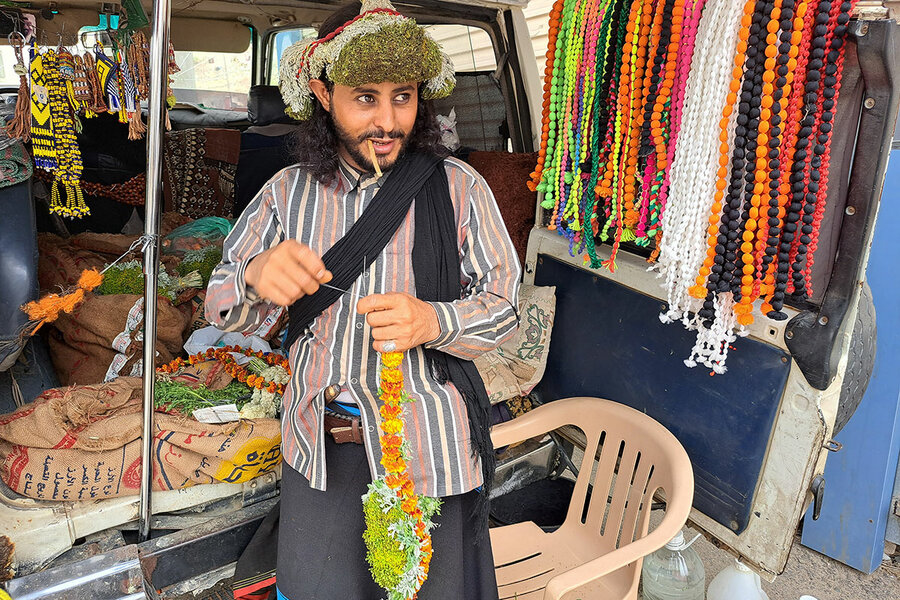Daisies and daggers: In Saudi mountains, garlands crown the brave
Loading...
| Al Dayer and Rijal Almaa, Saudi Arabia
In the mountainous areas of southwest Saudi Arabia, along the border with Yemen, tribesmen proudly wear outfits symbolizing the green mountains where they live and the fighting prowess they use to defend them.
Curved daggers are must-have accessories, hanging from the middle of their leather belts like sharpened buckles. But no warrior’s outfit is complete without a splash of color: Marigolds, daisies, and wild basil – flowery wreaths are the go-to headwear for tribesmen here, showing a flair for fashion. If the knives signal toughness, these wreaths are their swagger.
Why We Wrote This
A story focused onDo beauty and bravery go together? As values they’re not opposite, though perhaps incongruous for some. But in the remote southwest corner of Saudi Arabia, their pairing makes perfect sense.
Men of all ages sport full-on peacock blooms as they farm, shop, or attend weddings. And they insist, that rather than contradict or clash, bravery and beauty in these mountain villages go hand in hand.
“You got to have the flowers,” says a garland vendor, Mufleh.
Local historian and heritage expert Gebran Al Maliki says people decorating their homes and attire looked to their environment for inspiration. “They were surrounded by greenery, flowers, and bright colors, so they incorporated them into their outfits,” he says.
“Weapons and flowers are both important parts of daily life,” he adds.
In southwest Saudi Arabia, menswear is blooming – literally.
Here in the mountainous areas of Al Dayer and Asir along the Saudi-Yemeni border, tribesmen proudly wear outfits symbolizing the green mountains where they have lived for centuries and the fierce fighting prowess they use to defend them.
Curved janbiya daggers, must-have accessories in the southern Arabian Peninsula, hang from the middle of their leather belts like sharpened, deadly belt buckles.
Why We Wrote This
A story focused onDo beauty and bravery go together? As values they’re not opposite, though perhaps incongruous for some. But in the remote southwest corner of Saudi Arabia, their pairing makes perfect sense.
But no warrior’s outfit is complete without a splash of color.
“You got to have the flowers,” says a vendor, Mufleh, who gave only his first name.
Marigolds, daisies, and wild basil – flowery wreaths are the go-to headwear for tribesmen here, showing off a flair for fashion and an eye for color. If the knives signal toughness, these wreaths are their swagger.
With men of all ages sporting full-on peacock blooms as they farm, shop, or attend weddings, floral garlands are part and parcel of daily life in these hardscrabble mountain villages where a daisy is just as important as a dagger.
Rather than contradict or clash, they insist bravery and beauty here go hand in hand.
Although now Instagrammable destinations, many of these remote villages nestled in the mountains of Al Dayer and Asir in the Jazan region had long been largely closed off due to poor roads.
But investment and improved infrastructure in recent decades have paved the way for a tourism boom, with Saudis over the past six years discovering both these lush mountains and the tribesmen’s headwear.
Nature as inspiration
Unlike the arid expanse of central and northern Saudi Arabia or the hot and humid Red Sea coast, this mountainous region has a temperate climate, with dry air alternating with misty rains. That allows dozens of varieties of wild flowers to flourish for most of the year, making them available as a natural headwear for tribes straddling both sides of the Saudi-Yemeni border for centuries.
“When people decorated their homes or dressed up, they looked to their surroundings for inspiration,” says local historian and heritage expert Gebran al Maliki. “They were surrounded by greenery, flowers, and bright colors, so they incorporated them into their outfits.”
As they have for centuries, locals weave different combinations of sagebrush, wild basil, rue shrubs, fenugreek, and other scented plants into a sturdy crown, and then place strings of vibrant flowers loosely atop.
Those in a hurry place a small bouquet of aromatic herbs and flowers in their shirt pocket like a boutonniere.
But the flowers are not an indication of frivolity.
Up until the 1960s, young men embarked on at-times deadly public tests of pain and strength as a rite of passage. Bravery and honor are paramount; locals still brandish rifles and proudly help guard the border region as they have since the 1930s – even as war rages in Yemen a few miles away.
The intimidating arson of weapons carried by these tribes is on display at Mr. Al Maliki’s Jabal Tallan cultural museum in Al Dayer Bani Malik, from spears and daggers to modern rifles.
“Weapons and flowers are both important parts of daily life,” he says.
Wearable aromatherapy
But how do the flower men of southern Saudi Arabia choose which flowers to wear?
“It’s all down to a person’s individual tastes and sense of style,” Mr. Al Maliki says, pointing to the flowerless wreath of wild basil and rue atop his head.
“Just as people pick out a certain outfit in the morning, people here pick out the color combination of flowers they feel best represents them and makes them look good.”
But flowery wreaths are not just about looks. These garlands are prized for how they make you feel.
“When you put the wreath on your head, you feel calm,” says Ibrahim Fathy, a tour guide and historian who hosts visitors in a traditional stone home overlooking the center of the gingerbread town of Rijal Almaa in Asir.
The sage, wild basil, fenugreek, and other herbs give off a soothing scent throughout the day, acting as wearable aromatherapy.
“The wreaths give off a pleasant aroma and a calming sensation, relaxing your scalp and elevating your mood. It’s decoration, but it is also pleasing to the other senses.”
Traditionally, tribes in Al Dayer and Asir grew flowers and aromatic plants around their home and farms specifically for their daily crowns, a system that could not keep pace with the surging demand for flower headwear driven by population growth and domestic tourism.
Now farms an hour’s drive away cultivate marigolds, chrysanthemums, tulips, rue, and other herbs for area vendors to sell to residents and visitors alike year-round.
A rush on wreaths
The business has made Mufleh’s roadside flower van on the outskirts of Al Dayer the hottest spot in town.
Pickup trucks rumble in and peel off from his roadside spot like a drive-thru hamburger joint or gas station, yelling out their order from the driver’s side window: Add some yellow flowers to my wreath. Give me a string of white.
Hurry up, brother! I have a dinner to attend.
Staking out from 10 a.m. to 6 p.m., Mufleh gets the morning rush of farmers and commuters starting their day and the late afternoon crowd looking to spruce themselves up ahead of an evening out.
“If there is a wedding or celebration in town, I will have hundreds of orders,” Mufleh says as he gingerly threads a string of marigolds to add to a customer’s wreath. “People want to look their best – especially when there is a crowd.”
It is a desire that has caught on with visitors.
Many of the thousands of out-of-town Saudis who drive up to the misty mountains of Asir each weekend to escape the summer heat buy wreaths of yellow and orange flowers from vendors, with men and women proudly wearing them throughout their stay as they picnic in nature reserves, explore cliff-rock villages, sit in trendy cafes, and take evening strolls along the promenade.
The flower wreaths sold by Salim and his friends at the Jabal Sawda mountain are so eye-catching that they launched their own TikTok channel showcasing their flowery wares.
“People like to look beautiful, smell something nice, and wear something that is from the area,” Salim says.
“After all, who doesn’t like flowers?”











